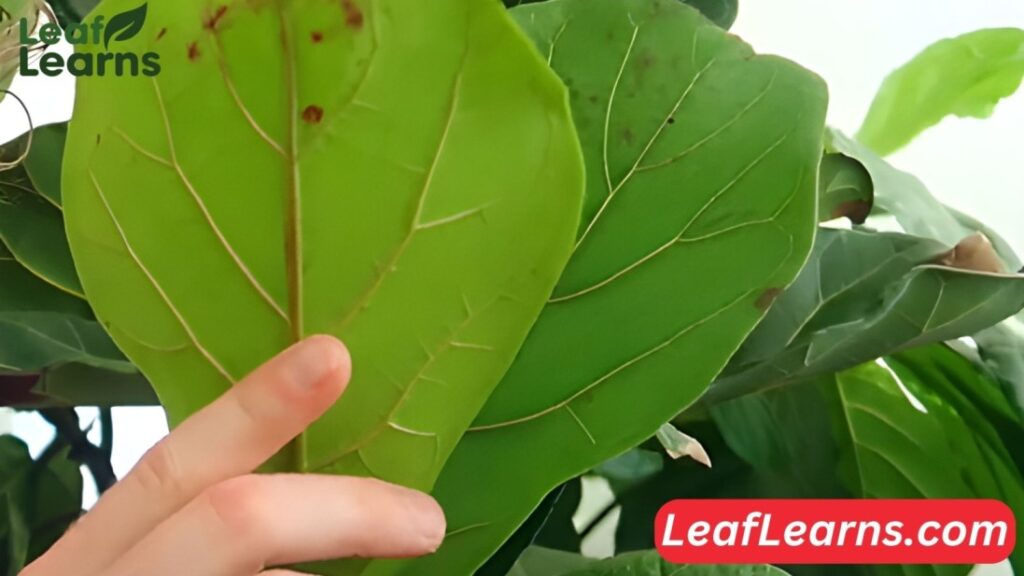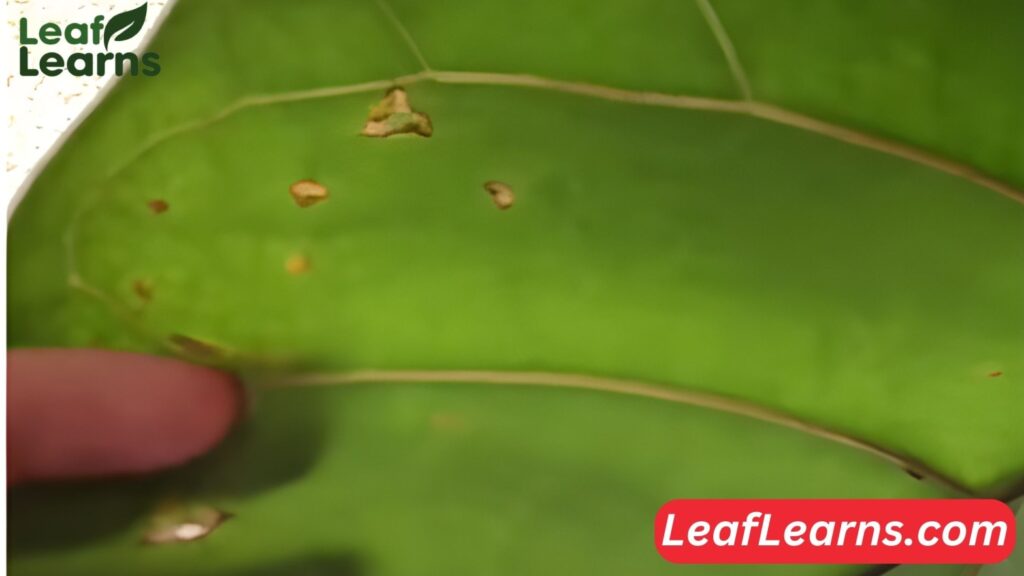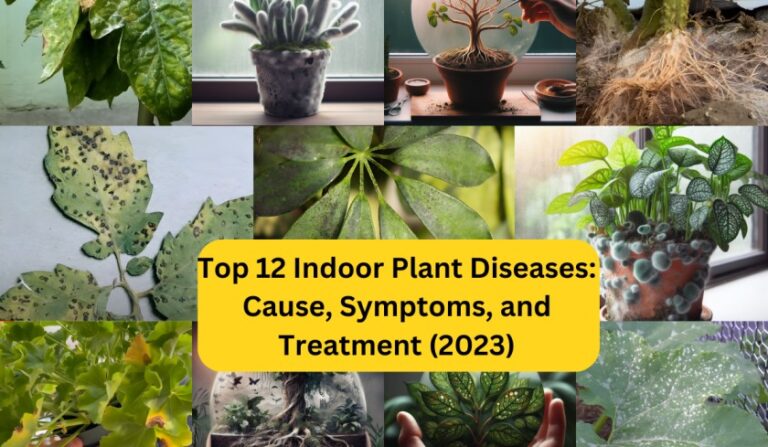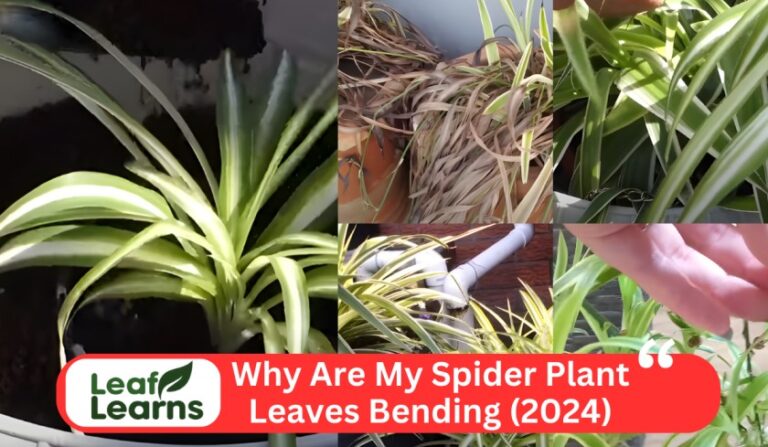How to Treat Fiddle Leaf Fig Edema (Red Spots) 2024
Fiddle Leaf Fig edema, or swollen leaves, as a result of over-watering. The leaves swell up when the roots are in the water for an extended period because they are unable to breathe. Water less often and allow the soil to dry out in between applications to remedy this. Repotting the plant in well-draining soil might also be beneficial.

To keep your plant happy and healthy, watch for indications that it is receiving too little or too much water. Overwatering is not the only source of red spots on Fiddle Leaf Figs; insects, diseases, or excessive sun exposure can also produce these marks.
Contents
- 1 What Is Edema?
- 2 What Causes Edema On Fiddle Leaf Fig
- 3 Why Does My Fiddle Leaf Fig Have Edema?
- 4 How to Diagnose Edema on Fiddle Leaf Fig Leaves
- 5 Does Edema Go Away?
- 6 How Can I Treat/Remove Fiddle Leaf Fig edema?
- 7 How Can I Prevent Edema On Fiddle Leaf Fig?
- 8 Key Aspects of Fiddle Leaf Fig Edema Care
- 9 Final thoughts
- 10 FAQs
What Is Edema?
Swelling brought on by extra fluid that becomes lodged in bodily tissues is known as edema. It appears as elevated, corky patches on plants, usually on the underside of leaves.
The main causes of it are things like overwatering, which prevents the plant from releasing extra water. Preventing edema with appropriate draining and watering techniques preserves the general health and aesthetic appeal of your plant, even if it is not immediately detrimental.
What Causes Edema On Fiddle Leaf Fig
The edema that this ailment creates is not hazardous per se; nevertheless, by knowing what causes it, you can keep your cherished fiddle leaf fig healthy and prevent further episodes.
Improper Moisture Management
An important factor contributing to edema is inconsistent irrigation. An imbalance where the roots absorb more water than the leaves can result from overwatering, especially when combined with inadequate drainage.
The cells are under pressure from the extra moisture, which explodes the cells and leaves behind the characteristic red blotches.
Poor Drainage
Another moisture-related aspect that contributes to edema is inadequate drainage. Make sure to use a well-draining potting mix and to check for drainage holes in your fiddle leaf fig pot.
This effectively lets extra water leave, avoiding waterlogging and the ensuing cell rupture.
Spider Mites and False Spider Mites
Both spider mites and fake spider mites can leave behind tiny, red spots on the leaves of fiddle leaf figs, albeit they are not the most prevalent cause.
The leaves of these pests also get stippling, yellowing, and webbing. Isolate your plant and look for alternatives for treatment, such as neem oil sprays or insecticidal soap, if you think there are pests.
Bacterial or Fungal Infection
Red dots on leaves can also be an indication of bacterial or fungal diseases, albeit they are less common than edema.
However, wilting, yellowing, and mushy, rotting tissues are common extra symptoms associated with these illnesses.
It is advised that you seek the advice of a qualified plant specialist for diagnosis and treatment if you think you may have an infection.
Beyond Moisture: Other Contributing Factors
While moisture management plays a pivotal role, other environmental factors can also contribute to the development of fiddle leaf fig edema:
- High Humidity: Although fiddle leaf figs usually prefer a moderate level of humidity, high levels of humidity can occasionally worsen edema, particularly when combined with erratic watering.
- Lower Light Levels: Fiddle leaf figs do well in indirect, bright light. When a plant receives excessive water, transpiration may be impeded by inadequate light, which increases the risk of edema.
- Low Temperatures: When watering practices stay the same, cooler temperatures might slow down the rate of transpiration, increasing the risk of edema.
- Nutrient-Deficient Soil: Your fiddle leaf fig may become less resilient to a variety of pressures, including those that cause edema, as a result of nutrient deficits that impair its general health.

Why Does My Fiddle Leaf Fig Have Edema?
It might be unsettling to see red or brown patches on your cherished fiddle leaf fig, but do not panic! These areas might be a clear indicator of edema, a prevalent condition.
When a plant takes in more water than it can transpire or release through its leaves, it develops edema, which is characterized by burst cells that result in these tiny, bumpy imperfections.
Several factors can contribute to fiddle leaf fig edema:
Inconsistent watering: The plant’s equilibrium for water intake and release can be upset by oscillating between dry spells and times of excessive irrigation.
High humidity: Although fiddle leaf figs like a moderate level of humidity, high levels of humidity can prevent transpiration and cause edema.
Temperature fluctuations: Abrupt temperature changes, particularly in the winter, might hinder transpiration and hasten the onset of edema.
Nutrient imbalances: Cell walls that aren’t getting enough calcium, for example, might become weaker and more prone to rupturing under pressure.
How to Diagnose Edema on Fiddle Leaf Fig Leaves
Before jumping to conclusions, it’s crucial to properly diagnose the spots on your fiddle leaf fig. Here are some key characteristics of edema:
- Size and location: Usually appearing as tiny, elevated patches (1-3 mm), edema mostly affects the undersides of newly formed leaves.
- Color: These patches don’t expand and stay the same size and color, but they may seem brown or reddish-brown.
- No holes: In contrast to insect or fungal damage, edema doesn’t cause holes or scabs on the leaves.
Does Edema Go Away?
The good news is that minor edema will generally fade away as the leaves grow and won’t affect your fiddle leaf fig. To stop such incidents, it’s crucial to treat the root reason, though.
You may give your fiddle leaf fig a more balanced environment and stop edema breakouts in the future by changing the way you water it, increasing air circulation, and keeping the temperature constant.
How Can I Treat/Remove Fiddle Leaf Fig edema?
Edema is a frequent problem brought on by too much moisture and is indicated by elevated, corky lumps on the underside of leaves.
Although it is not possible to “remove” edema damage that has already occurred, there are actions you can take to avoid future occurrences and improve the health of your plants overall.
Let Your Plant’s Soil Dry Out
Edema is mostly caused by over watering. In between watering, let the top inch of soil dry completely. This keeps water logging from occurring and promotes healthy root respiration.
Check Humidity Levels
The ideal humidity range for fiddle leaf figs is between 40 and 50 percent. Overly high humidity can cause edema by trapping moisture around the leaves. If you need more humidity, think about using a humidifier or putting your plant next to a wet pebble tray.
Remove Any Pest Infestations
Infestations of pests can weaken your plant and increase its susceptibility to edema. Check your fiddle leaf fig frequently for pest indications, such as mealybugs or spider mites.
Apply the proper insecticidal treatments as soon as possible to any infestations.
Resolve Any Bacterial Infections
Another factor that might cause edema is bacterial infections. If you think there may be a bacterial problem, separate the plant and get advice from a horticulturist for a diagnosis and recommended course of action.
Address Any Fungal Infections
One of the many signs of fungal illnesses is edema. Isolate the plant and get expert advice for a diagnosis and suitable fungicide application if you suspect a fungal infestation.
Correct Sun Damage
Your fiddle leaf fig may become stressed from prolonged sun exposure and become more prone to edema. Make sure the sunlight reaching your plant is bright and indirect. Steer clear of intense, direct sunlight all day.
Double Check Your Watering Schedule
Adapt your watering regimen to the demands of your particular plant and the season. When the top inch of soil is completely dry, thoroughly water the pot, letting any extra water run. Refrain from leaving your plant submerged in water.
How Can I Prevent Edema On Fiddle Leaf Fig?
The magnificent fiddle leaf fig (FLF) is a popular houseplant, but it can be susceptible to edema – a condition causing raised, corky spots on the leaves. Here are key strategies to prevent this:
- Learn the “Moist, Not Soggy” Rule and water the soil only after the top inch dries off. Edoema is mostly caused by overwatering.
- Superior Drainage Is Crucial Make sure that the potting mix in your FLF container drains properly and that it has drainage holes. For further drainage, think about adding pumice or perlite.
- Allow Your FLF to Breathe: Steer clear of heavy misting as this might exacerbate edema by trapping moisture. Make sure there is adequate airflow around the plant.
- Light Is Everything: Bright, indirect sunshine is ideal for fiddle leaf fig growth. Inadequate light can impede the flow of water through transpiration and exacerbate edema.
- Don’t Use Too Much Fertiliser: Edoema can be brought on by overfertilization, which upsets the plant’s water balance. Apply a reasonable amount of diluted fertilizer during the growth season.

Key Aspects of Fiddle Leaf Fig Edema Care
Caring for a fiddle leaf fig (Ficus lyrata) involves several key aspects to ensure its health and vitality. Understanding the basics, such as fiddle leaf fig pflege (care) and proper watering techniques, is essential for maintaining a thriving plant.
Regularly checking for signs of edema, characterized by swelling and fluid retention, is crucial in preventing issues like fiddle leaf fig edema. This condition, which can manifest in various ways such as edema on fiddle leaf fig leaves or fiddle leaf fig edema symptoms like discoloration or lesions, requires careful attention and treatment to avoid complications.
Overwatering, indicated by brown spots or limp foliage, is a common concern, so knowing how to adjust watering practices and address symptoms like dry spots on fiddle leaf fig edema leaves is vital. By staying vigilant and addressing both general symptoms and specific issues like edema, fiddle leaf fig edema enthusiasts can ensure their plants thrive and flourish.
Final thoughts
Although fiddle leaf fig edema doesn’t directly damage your FLF, keeping it at bay maintains the visual attractiveness of your plant. By taking these precautions, you may foster an atmosphere that is healthy for your FLF and encourage the growth of its eye-catching leaves.
FAQs
How do you fix edema on fiddle leaf figs?
Unfortunately, it is not possible to “fix” edematous regions after they have formed. The damaged cells cannot be repaired. Fortunately, edema mostly affects the appearance and poses little threat to the general health of your plant. If you’d like, you can trim the impacted leaves, but it’s best to concentrate on avoiding such incidents from happening again.
How do you tell the difference between spider mites and edema in fiddle leaf figs?
Both can result in spotting on leaves, however, there are several important distinctions:
Edoema Leaves often have raised corky patches on the underside.
Spider mites: On the underside of leaves, there are tiny white or yellow dots and webbing that are frequently accompanied by yellowing or stippling on the upper surface.
If in doubt, carefully check the underside of leaves for webbing and make the distinction between spots and mites using a magnifying lens.
What does bacterial infection on fiddle leaf fig look like?
Though they are less frequent than edema, bacterial infections on fiddle leaf figs can result in dark, water-soaked sores on the leaves, stems, or both. The lesions have the potential to exude a gooey fluid and spread quickly. For advice on how to manage a suspected bacterial illness, speak with a professional gardener or your neighborhood nursery.






